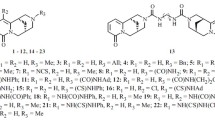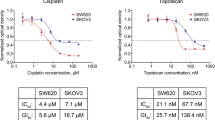Summary
In the present study a slightly modified MTT assay was used in conjunction with cell counting to determine the antiproliferative efficacy ofN-(2-chloroethyl)-N-nitroso-N′-2-hydroxyethylurea (HECNU), vinblastine, and hexadecylphosphocholine (HPC) in a panel of six tumor cell lines. This panel consisted of two human (MDA-MB231, MCF-7) and two rodent (1/C2, 1/C32) mammary-carcinoma cell lines as well as of two tumor cell lines of gastrointestinal origin (HT-29, KB). It was shown that the use of acid isopropanol as a solvent of the formazan crystals produced correlations between cell number and absorption that were as good as, if not better than, those seen after dimethylsulfoxide (DMSO) application. The optimal period of incubation with the MTT dye was 2 h. A comparison of the antiproliferative activity of HECNU revealed that the HT-29 cell line was most resistant [50% inhibition concentration (IC50), 138.7 μmol/l], followed by MCF-7 cells (IC50, 127.7 μmol/l), whereas MDA-MB231 cells showed the highest sensitivity (IC50, 6 μmol/l). Vinblastine induced the highest (MCF-7 cells; IC50, 0.68 nmol/l) and the lowest (1/C2 cells; IC50, 7.69 nmol/l) degrees of growth inhibition in cell lines derived from mammary carcinoma. This contrasted with the activity of HPC, which was considerably less effective in the four mammary-carcinoma cell lines (IC50 from 29.4 to 69.9 μmol/l) than in the two cell lines of gastrointestinal origin (IC50, 1.9 and 3.1 μmol/l). Interestingly, treatment with HPC stimulated the growth of 1/C32 cells in the lower dose range. After treatment with HECNU, the average IC50 value determined in the MTT assay was 2.4-fold that disclosed by cell counting, whereas the average values found for HPC and vinblastine by both methods corresponded fairly well, with the respective values obtained using the MTT assay being only 26% and 14% higher than those measured by cell counting. A dose-dependent increase in the mean size of MCF-7 cells was observed after exposure to HECNU, which — if taken into account — considerably reduced underestimation of this parameter by the MTT assay. No variation in cell size was noted following treatment with HPC and vinblastine. Thus, depending on the antitumor agent used, the MTT assay can result in slight or even considerable understimation of the antitumor efficacy of certain compounds and may need correction by consideration of the effect of the drugs on cell size.
Similar content being viewed by others
Abbreviations
- MTT:
-
3-(4,5-dimethylthiazol-2-yl)-2,5-diphenyltetrazolium bromide
- HECNU:
-
N-(2-ehloroethyl)-N-nitroso-N′-2-hydroxyethylurea
- HPC:
-
hexadecylphosphocholine
- MNU:
-
methylnitrosourea
- DMSO:
-
dimethylsulfoxide
- IC50 :
-
50% inhibitory concentration
- APC:
-
alkylphosphocholines
- PBS:
-
phosphoate-buffered saline
- fl:
-
femto litre
References
Alley MC, Scudiero DA, Monks A, Hursey ML, Czerwinski MJ, Fine DL, Abbott BJ, Mayo JG, Shoemaker RH, Boyd R (1988) Feasibility of drug screening with panels of human tumor cell lines using a microculture tetrazolium assay. Cancer Res 48:589
Angres G, Scherf HR (1989) Different effects of cyclophosphamide in vivo and phosphamide mustard in vitro on two cell clones of chemically induced mammary carcinoma of the rat. J Cancer Res Clin Oncol 115:203
Baehner RL, Nathan DG (1968) Quantitative nitroblue tetrazolium test in chronic granulomatous disease. N Engl J Med 278:971
Berger MR, Muschiol C, Schmähl D, Eibl HJ (1987) New cytostatics with experimentally different toxic profiles. Cancer Treat Rev 14:307
Campling BG, Pym J, Baker HM, Cole SP, Lam YM (1991) Chemosensitivity testing of small cell lung cancer using the MTT assay. Br J Cancer 63:75
Carmichael J, DeGraff WG, Gazdar AF, Minna JD, Mitchell JB (1987) Evaluation of a tetrazolium-based semiautomated colorimetric assay: assessment of chemosensitivity testing. Cancer Res 47:936
Collins SJ, Ruscetti FW, Gallagher RE, Gallo RC (1979) Normal functional characteristics of cultured human promyelocytic leukemia cells (HL-60) after induction of differentiation by dimethylsulfoxide. J Exp Med 149:969
Comley JC, Rees J, Turner CH, Jenkins DC (1989) Colorimetric quantitation of filarial viability. Int J Parasitol 19:77
Day SR, Ziolkowski CHJ, Scudiero DA, Meyer SA, Lubiniecki AS, Girardi AJ, Galloway SM, Bynum GD (1980) Defective repair of alkylated DNA by human tumour and SV40-transformed human cell strains. Nature 288:724
Ferrari M, Fornasiero MC, Isetta AM (1990) MTT colorimetric assay for testing macrophage cytotoxicity activity in vitro. J Immunol Methods 131:165
Givens KT, Kitada S, Chen AK, Rothschiller J, Lee DA (1990) Proliferation of human ocular fibroblasts. An assessment of in vitro colorimetric assays. Invest Ophthalmol Vis Sci 31:1856
Goldin A, Venditti JM, MacDonald JS, Muggia FM, Henney JE, DeVita VT (1981) Current results of the screening program at the Division of Cancer Treatment, National Cancer Institute. Eur J Cancer 17:129
Guillem JG, Levy MF, Hsieh LL, Johnson MD, LoGerfo P, Forde KA, Weinstein IB (1990) Increased levels of phorbin, c-myc, and ornithine decarboxylase RNAs in human colon cancer. Mol Carcinog 3:68
Heo DS, Park JG, Hata K, Day R, Herberman RB, Whiteside TL (1990) Evaluation of tetrazolium-based semiautomatic colorimetric assay for measurement of human antitumor cytotoxicity. Cancer Res 50:3681
Hida T, Ueda R, Takahashi T, Watanabe H, Kato T, Suyama M, Sugiura T, Ariyoshi Y, Takahashi T (1989) Chemosensitivity and radiosensitivity of small cell lung cancer cell lines studied by a newly developed 3-(4,5-dimethylthiazol-2-yl)-2,5-diphenyltetrazolium bromide (MTT) hybrid assay. Cancer Res 49:4785
Hochhuth C, Berkovic D, Eibl HJ, Unger C, Doenecke D (1990) Effects of antineoplastic phospholipids on parameters of cell differentiation in U937 cells. J Cancer Res Clin Oncol 116:459
Hongo T, Fujii Y, Igarashi Y (1990) An in vitro chemosensitivity test for the screening of anti-cancer drugs in childhood leukemia. Cancer 65:1263
Jabbar SAB, Twentyman PR, Watson JV (1989) The MTT assay underestimates the growth inhibitory effects of interferons. Br J Cancer 60:523
Kaleagasioglu F, Berger MR, Schmähl D, Eisenbrand G (1990) In vitro evaluation of 1-(2-chloroethyl)-1-nitroso-3-(2-hydroxyethyl)urea linked to 4-acetoxybisdesmethyltamoxifen, estradiol and dihydrotestosterone. Arzneimittelforschung 40:603
Kasugai S, Hasegawa N, Ogura H (1991) Application of the MTT colorimetric assay to measure cytotoxic effects of phenolic compounds on established rat dental pulp cells. J Dent Res 70:127
Kirkpatrick DL, Duke M, Goh TS (1990) Chemosensitivity testing of fresh human leukemia cells using both a dye exclusion assay and a tetrazolium dye (MTT) assay. Leuk Res 14:459
Klebe RJ, Harriss JV (1984) A technically simple “non-lethal” vital staining procedure for viral plaque and cell transformation assays. Brief report. Arch Virol 81:359
Levitz SM, Diamond RD (1985) A rapid colorimetric assay of fungal viability with the tetrazolium salt MTT. J Infect Dis 152:938
Manthorpe M, Fagnani R, Skaper SD, Varon S (1986) An automated colorimetric microassay for neuronotrophic factors. Brain Res 390:191
Miller RR, Mc Devitt CA (1991) A quantitative microwell assay for chondrocyte cell adhesion. Anal Biochem 192:380
Mosmann T (1983) Rapid colorimetric assay for cellular growth and survival: application to proliferation and cytotoxicity assays. J Immunol Methods 65:55
Muschiol C, Berger MR, Schuler B, Scherf HR, Garzon FT, Zeller WJ, Unger C, Eibl HJ, Schmähl D (1987) Alkyl phosphocholines: toxicity and anticancer properties. Lipids 22:930
Peck R (1985) A one-plate assay for macrophage bactericidal activity. J Immunol Methods 82:131
Pieters R, Huismains DR, Loonen AH, Hählen K, Van der Does van den Berg A, Van Wering ER, Veerman AJP (1990) Relation of cellular drug resistance to long-term clinical outcome in childhood acute lymphoblastic leukaemia. Lance 338:399
Pieters R, Loonen AH, Huismains DR, Broekema GJ, Diryen MWJ, Heyenbrok MW, Hählen K, Veerman AJP (1990) In vitro drug sensitivity of cells from children with leukemia using the MTT assay with improved culture conditions. Blood 76:2327
Plumb JA, Milroy R, Kaye SB (1989) Effects of the pH dependence of 3-(4,5-dimethylthiazol-2-yl)-2,5-diphenyltetrazolium bromideformazan absorption on chemosensitivity determined by a novel tetrazolium assay. Cancer Res 49:4435
Price P, McMillan TJ (1990) Use of the tetrazolium assay in measuring the response of human tumor cells to ionizing radiation. Cancer Res 50:1392
Ross DW (1976) Cell volume growth after cell cycle block with chemotherapeutic agents. Cell Tissue Kinet 9:379
Sargent JM, Taylor CG (1989) Appraisal of the MTT assay as a rapid test of chemosensitivity in acute myeloid leukaemia. Br J Cancer 60:206
Schmähl D, Berger MR (1988) Possibilities and limitations of antineoplastic chemotherapy: experimental and clinical aspects. Int J Exp Clin Chemother 1:1
Schneider SL, Fuqua SAW, Speeg KV, Tandon AK, McGuire WL (1990) Isolation and characterization of an Adriamycin-resistant breast tumor cell line. In Vitro Cell Dev Biol 26:621
Scudiero DA, Shoemaker RH, Paull KD, Monks A, Tierney S, Nofziger TH, Currens MJ, Seniff D, Boyd MR (1988) Evaluation of a soluble tetrazolium/formazan assay for cell growth and drug sensitivity in culture using human and other tumor cell lines. Cancer Res 48:4827
Sobottka SB, Berger MR (1991) Antitumor properties of octadecylphosphocholine (OPC),D 9-trans-oleylphosphocholine (t-OlPC) andD 9-cis-oleylphosphocholine (c-OlPC) in vitro. J Cancer Res Clin Oncol 117 [Suppl]:36
Überall F, Oberhuber H, Maly K, Zaknun J, Demuth L, Grunicke HH (1991) Hexadecylphosphocholine inhibits inositol phosphate formation and protein kinase C activity. Cancer Res 51:807
Van de Loosdrecht AA, Nennie E, Ossenkoppele GJ, Beelen RH, Langenhuijsen MM (1991) Cell mediated cytotoxicity against U 937 cells by human monocytes and macrophages in a modified colorimetric MTT assay. J Immunol Methods 141:15
Venditti JM (1981) Preclinical drug development: rationale and methods. Semin Oncol 8:349
Wassermann TH, Twentyman P (1988) Use of colorimetric microtiter (MTT) assay in determining the radiosensitivity of cells from murine solid tumors. Int J Radiat Oncol Biol Phys 15:699
Wei LL, Katzenellenbogen BS, Robertson DW, Simpson DM, Katzenellenbogen JA (1986) Nitrosourea and nitrosocarbamate derivatives of the antiestrogen tamoxifen as potential estrogen receptor-mediated cytotoxic agents in human breast cancer cells. Breast Cancer Res Treat 7:77
Weislow OS, Kiser R, Fine DL (1989) New soluble-formazan assay for HIV-1 cytopathic effects: application to high-flux screening of synthetic and natural products for AIDS-antiviral activity. J Natl Cancer Inst 81:577
Wilson JK, Sargent JM, Elgie AW, Hill JG, Taylor CG (1990) A feasibility study of the MTT assay for chemosensitivity testing in ovarian malignancy. Br J Cancer 62:189
Zeller WJ, Berger MR (1984) Chemically induced autochthonous tumor models in experimental chemotherapy. Behring Inst Mitt 74:201
Author information
Authors and Affiliations
Rights and permissions
About this article
Cite this article
Sobottka, S.B., Berger, M.R. Assessment of antineoplastic agents by MTT assay: partial underestimation of antiproliferative properties. Cancer Chemother. Pharmacol. 30, 385–393 (1992). https://doi.org/10.1007/BF00689967
Received:
Accepted:
Issue Date:
DOI: https://doi.org/10.1007/BF00689967




